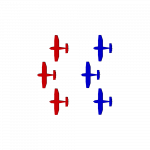
Communication is of utmost importance. If you want to fly from or to a controlled airfield, such as Rotterdam, Schiphol, Lelystad, or Groningen, you need an RT certificate. With this, you prove that you know the radio procedures and are able to use them well.
In formation flying, communication is even more important. The reason being the proximity of the aircraft to one another. Below, you will find some of the most common radio calls we use during our training. The leader always initiates these calls. The other pilots only reply during a formation check-in, or in case something does not go according to plan (for example, they cannot keep off and have to leave the formation, to rejoin later).
Formation check-in
In formation, every aircraft has its own number. For the Box Formation (the default formation) the leader is number 1, the aircraft on its left wing is number 2, on its right wing number 3, right behind the leader number 4. The aircraft on number 4’s left wing is number 5, and on number 4’s right wing, you will find number 6. In case there is a number 7, he will be directly behind the number 4.
The formation check-in helps the leader to check if all aircraft have their radios on the correct frequency. This is necessary, because taxiing and moving around the airfield is done on the tower frequency, but after departure, the formation will change to another frequency for air-to-air communication. After every frequency change, the leader will call out a formation check-in. All aircraft answer with their number, in the correct order.
Delta formation, delta formation, go
To initiate a formation change, the name of the next formation is called twice, followed by the word ‘go’. This is the signal to start moving and allows formation changes to partake smoothly and safely.
Other examples include ‘back in box, back in box, go’ or ‘eagle formation, eagle formation, go’.
Prepare for crossbreak

This call is used to initiate a crossbreak. Because during a crossbreak, the airplanes’ paths cross directly in front of one another, they need more separation than in a normal formation. When preparing for a crossbreak, half of the formation flies on the left side and the other half flies on the right side.
From the audience’s perspective, a crossbreak makes it seems like the planes will fly into each other. The ones at the back fly up straight, crossing through the paths of the planes in front. Distance offers safety, in exchange for a spectacular sight.
In position
Due to the distance between the planes before a crossbreak, the leader can no longer see all aircraft. Therefore, he relies on the last pilot to call out ‘in position’, so he knows when he can start counting down.
Dive for the break
A crossbreak requires quite some speed, as the planes quickly pull up or pull to the side. For this, they first need to fly down to pick up airspeed. We’re not flying with Extra 300s, after all! 🙂 This move is initiated by ‘dive for the break’.
Prepare for the pull
The departure route from the airfield to Hook of Holland is positioned at 1000 feet (about 300 meters above the ground). Once the formation is out of the CTR, they want to climb to 1500 feet. This has several reasons: 1) more air below = space to fix mistakes and 2) less noise for the people on the ground. The way the formation climbs to 1500 feet is with a ‘pull’: the airplanes simultaneously pull up. For this they need speed, therefore the leader needs to call out ‘prepare for the pull’ to make sure everyone’s got their throttle a bit further forward.
Blue Section, detach
 The Blue Section is the second group of a formation. In the Victor Romeo Formation, the Blue Section exists when there is a formation of five or six (or seven) aircraft. For a formation landing, the Blue Section needs to split from the Red Section as only three aircraft can land at the same time. Therefore, the leader will call out ‘Blue Section, detach’ so everyone knows to split off and prepare for landing.
The Blue Section is the second group of a formation. In the Victor Romeo Formation, the Blue Section exists when there is a formation of five or six (or seven) aircraft. For a formation landing, the Blue Section needs to split from the Red Section as only three aircraft can land at the same time. Therefore, the leader will call out ‘Blue Section, detach’ so everyone knows to split off and prepare for landing.
Number one, turning in
Right before an individual landing (these are done when there is too much crosswind for a safe formation landing) the leader will always call out when he is turning to base and final. He will then call out ‘number one, turning in’.